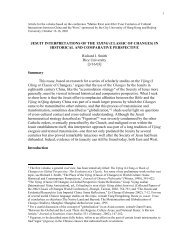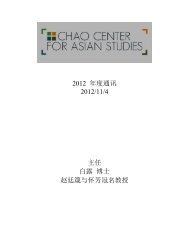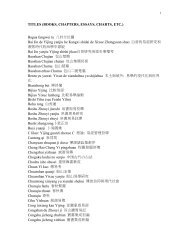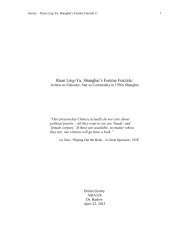28Let us now look at an example <strong>of</strong> how a Evidential Studies-oriented Q<strong>in</strong>g scholar mightgloss a passage related to an early Changes div<strong>in</strong>ation, consider Mao Qil<strong>in</strong>g’s<strong>in</strong>terpretation <strong>of</strong> an anecdote from <strong>the</strong> Zuo Commentary—Duke Mu <strong>of</strong> Q<strong>in</strong>’s punitiveexpedition aga<strong>in</strong>st Duke Hui <strong>of</strong> J<strong>in</strong> <strong>in</strong> 645 BCE. Here is <strong>the</strong> orig<strong>in</strong>al story:Be<strong>for</strong>e <strong>the</strong> attack, Duke Mu asked his div<strong>in</strong>er, Tufu, to consult <strong>the</strong> Changes regard<strong>in</strong>g <strong>the</strong>outcome. Tufu selected <strong>the</strong> hexagram Gu (number 18 <strong>in</strong> <strong>the</strong> received order; seeillustration below). The judgment <strong>of</strong> this hexagram reads <strong>in</strong> part: “Favorable <strong>for</strong> cross<strong>in</strong>ga big river.” The div<strong>in</strong>er thus predicted victory (<strong>in</strong> apparently extemporaneous rhymedverse), remark<strong>in</strong>g <strong>the</strong>reafter that Duke Mu’s troops would cross <strong>the</strong> Yellow Riverseparat<strong>in</strong>g Q<strong>in</strong> from J<strong>in</strong>, defeat <strong>the</strong> <strong>for</strong>ces <strong>of</strong> Duke Hui, <strong>and</strong> arrest <strong>the</strong> duke. He expla<strong>in</strong>edthat s<strong>in</strong>ce <strong>the</strong> <strong>in</strong>ner (lower) trigram <strong>of</strong> Gu was Sun (W<strong>in</strong>d), <strong>and</strong> <strong>the</strong> outer (upper) one wasGen (Mounta<strong>in</strong>), <strong>the</strong> w<strong>in</strong>ds <strong>of</strong> Q<strong>in</strong> would blow down <strong>the</strong> “fruits” <strong>of</strong> J<strong>in</strong> on <strong>the</strong> mounta<strong>in</strong><strong>and</strong> <strong>the</strong>ir assets would be seized. That is, Q<strong>in</strong> would prevail <strong>in</strong> <strong>the</strong> struggle.If we turn to Mao Qil<strong>in</strong>g’s analysis, however, which reflects <strong>the</strong> obvious legacy <strong>of</strong> Hanstyleexegesis, we see an account that differs substantially from <strong>the</strong> orig<strong>in</strong>al explanation<strong>of</strong>fered by Duke Mu’s div<strong>in</strong>er. Mao beg<strong>in</strong>s by not<strong>in</strong>g that <strong>the</strong> idea <strong>of</strong> “cross<strong>in</strong>g a bigriver” <strong>in</strong> <strong>the</strong> judgment is derived from <strong>the</strong> lower four l<strong>in</strong>es <strong>of</strong> Gu, which resemble <strong>the</strong>Kan trigram (<strong>the</strong> symbol <strong>of</strong> water) <strong>in</strong>asmuch as <strong>the</strong>y consist <strong>of</strong> a pair <strong>of</strong> yang l<strong>in</strong>esconta<strong>in</strong>ed between two y<strong>in</strong> l<strong>in</strong>es. In o<strong>the</strong>r words, Mao <strong>in</strong>terprets <strong>the</strong> four lowest l<strong>in</strong>esvisually as if <strong>the</strong>y were three. Secondly, he po<strong>in</strong>ts out that <strong>the</strong> upper nuclear trigram <strong>of</strong>Gu—that is, l<strong>in</strong>es 3, 4 <strong>and</strong> 5—is Zhen, which is not only <strong>the</strong> symbol <strong>of</strong> a feudal lord, butalso that <strong>of</strong> an upturned bowl, which resembles <strong>the</strong> body <strong>of</strong> a chariot. S<strong>in</strong>ce <strong>the</strong> upperprimary trigram (Gen) is Zhen turned upside down, this <strong>in</strong>dicates <strong>the</strong> overthrow <strong>of</strong> DukeHui. And because Gen symbolizes both <strong>the</strong> h<strong>and</strong>s <strong>and</strong> <strong>the</strong> idea <strong>of</strong> stoppage (accord<strong>in</strong>g to<strong>the</strong> Expla<strong>in</strong><strong>in</strong>g <strong>the</strong> Trigrams commentary), <strong>the</strong> mean<strong>in</strong>g conveyed is <strong>the</strong> arrest <strong>of</strong> DukeHui. This notion is re<strong>in</strong><strong>for</strong>ced by consideration <strong>of</strong> <strong>the</strong> hexagram Sui (number 17), <strong>the</strong>opposite <strong>of</strong> Gu, <strong>in</strong> which <strong>the</strong> l<strong>in</strong>e read<strong>in</strong>gs refer repeatedly to ty<strong>in</strong>g someone up,presumably Duke Hui.GuSuiWe can now fast-<strong>for</strong>ward to 1905. In that year, as part <strong>of</strong> a re<strong>for</strong>m movement designed to“modernize” Ch<strong>in</strong>a <strong>in</strong> <strong>the</strong> aftermath <strong>of</strong> <strong>the</strong> disastrous S<strong>in</strong>o-Japanese War <strong>of</strong> 1894-5, <strong>the</strong>Q<strong>in</strong>g government abolished <strong>the</strong> civil service exam<strong>in</strong>ation system, which had re<strong>in</strong><strong>for</strong>cedCheng-Zhu orthodoxy <strong>and</strong> <strong>the</strong> authority <strong>of</strong> <strong>the</strong> Yij<strong>in</strong>g <strong>and</strong> o<strong>the</strong>r Confucian classics <strong>for</strong>nearly seven hundred years. Less than a decade later, <strong>the</strong> Q<strong>in</strong>g dynasty itself fell torepublican revolution, end<strong>in</strong>g any semblance <strong>of</strong> <strong>of</strong>ficial patronage <strong>of</strong> classicalscholarship.
29In this new post-imperial environment, as <strong>in</strong> earlier periods, studies <strong>of</strong> <strong>the</strong> Changesfollowed <strong>the</strong> general contours <strong>of</strong> Ch<strong>in</strong>ese political, social <strong>and</strong> <strong>in</strong>tellectual life. For awhile,some classically tra<strong>in</strong>ed Ch<strong>in</strong>ese scholars cont<strong>in</strong>ued to use exegesis <strong>of</strong> <strong>the</strong> Yij<strong>in</strong>g todisplay <strong>the</strong>ir erudition, <strong>and</strong> a few “tradition-m<strong>in</strong>ded” <strong>in</strong>dividuals still viewed <strong>the</strong>document as a sacred scripture. At least one scholar, Wang Xiangxuan (; fl.1915), even wrote a syncretic book <strong>in</strong> Ch<strong>in</strong>ese titled Unity <strong>of</strong> <strong>the</strong> Changes (Yitong ),<strong>in</strong> which he attempted to reconcile Confucianism, Daoism, Buddhism, Islam, Judaism<strong>and</strong> Christianity. But <strong>in</strong>creas<strong>in</strong>gly, Ch<strong>in</strong>ese <strong>in</strong>tellectuals came to view <strong>the</strong> Yij<strong>in</strong>g assimply an historical artifact—one that had no practical or spiritual value <strong>for</strong>contemporary Ch<strong>in</strong>ese society. Contribut<strong>in</strong>g mightily to this self-consciously “secular”approach to <strong>the</strong> Changes was a burst <strong>of</strong> Ch<strong>in</strong>ese scholarship based on new archaeologicaldiscoveries <strong>and</strong> a new-found fasc<strong>in</strong>ation with <strong>the</strong> “scientific method.”Guo Moruo’s (; 1892-1978) studies <strong>of</strong> <strong>the</strong> Yij<strong>in</strong>g, beg<strong>in</strong>n<strong>in</strong>g with his celebrated1927 article, “Life <strong>and</strong> Society <strong>in</strong> <strong>the</strong> Era <strong>of</strong> <strong>the</strong> Zhou Changes,” marked <strong>the</strong> beg<strong>in</strong>n<strong>in</strong>g <strong>of</strong>a long period <strong>in</strong> Ch<strong>in</strong>a dur<strong>in</strong>g which Marxist categories <strong>and</strong> concerns played a major role<strong>in</strong> <strong>the</strong> analysis <strong>of</strong> <strong>the</strong> Yij<strong>in</strong>g. Soon <strong>the</strong>reafter, humanistic opponents <strong>of</strong> Marxistmaterialism, <strong>in</strong>clud<strong>in</strong>g Xiong Shili (; 1885-1968) <strong>and</strong> Fang Dongmei (;1899-1977), began to champion <strong>the</strong> Changes as a means <strong>of</strong> revitaliz<strong>in</strong>g traditionalCh<strong>in</strong>ese thought, Confucianism <strong>in</strong> particular.Follow<strong>in</strong>g <strong>the</strong> establishment <strong>of</strong> <strong>the</strong> People’s Republic <strong>of</strong> Ch<strong>in</strong>a <strong>in</strong> 1949 <strong>and</strong> until 1978,this <strong>in</strong>tellectual struggle persisted as part <strong>of</strong> <strong>the</strong> larger political rivalry between <strong>the</strong>Ch<strong>in</strong>ese Ma<strong>in</strong>l<strong>and</strong> <strong>and</strong> Taiwan. But <strong>in</strong>tellectual liberalization <strong>in</strong> <strong>the</strong> PRC after 1978vastly exp<strong>and</strong>ed <strong>the</strong> <strong>in</strong>terpretive parameters <strong>of</strong> Yij<strong>in</strong>g scholarship, as well as <strong>the</strong> scope <strong>of</strong>more popular writ<strong>in</strong>g. Confucianism (<strong>and</strong> to a lesser degree, Buddhism <strong>and</strong> Daoism) wasno longer a dirty word on <strong>the</strong> Ma<strong>in</strong>l<strong>and</strong>, <strong>and</strong> <strong>the</strong> past <strong>in</strong>creas<strong>in</strong>gly seemed at leastpossibly relevant to <strong>the</strong> Ch<strong>in</strong>ese present <strong>and</strong> future. As a result, from <strong>the</strong> 1980s to today<strong>the</strong>re has been a surge <strong>of</strong> <strong>in</strong>terest <strong>in</strong> <strong>the</strong> Changes on both sides <strong>of</strong> <strong>the</strong> Taiwan Straitunprecedented s<strong>in</strong>ce <strong>the</strong> Q<strong>in</strong>g dynasty.One <strong>of</strong> <strong>the</strong> most <strong>in</strong>terest<strong>in</strong>g features <strong>of</strong> contemporary writ<strong>in</strong>g on <strong>the</strong> Yij<strong>in</strong>g—<strong>in</strong> addition to ahuge outpour<strong>in</strong>g <strong>of</strong> traditional-style exegetical work—has been an ef<strong>for</strong>t by a number <strong>of</strong>Ch<strong>in</strong>ese scholars (<strong>and</strong> a few Western ones) to explore possible connections between <strong>the</strong>Changes <strong>and</strong> modern scientific ideas, from l<strong>in</strong>ear algebra <strong>and</strong> quantum mechanics to <strong>the</strong>fields <strong>of</strong> molecular biology <strong>and</strong> computer cod<strong>in</strong>g. Thus, we have <strong>in</strong>dividuals such as Yang Li() argu<strong>in</strong>g <strong>in</strong> <strong>the</strong> same basic ve<strong>in</strong> as Fang Yizhi <strong>and</strong> Jiang Yong <strong>in</strong> <strong>the</strong> Q<strong>in</strong>g period that<strong>the</strong> numbers <strong>of</strong> <strong>the</strong> Yellow River Chart <strong>and</strong> <strong>the</strong> Luo River Writ<strong>in</strong>g are “<strong>the</strong> deriv<strong>in</strong>gcoefficient” <strong>of</strong> everyth<strong>in</strong>g <strong>in</strong> <strong>the</strong> cosmos. Similarly, Feng Youlan () contends that <strong>the</strong>Yij<strong>in</strong>g conta<strong>in</strong>s an <strong>in</strong>cipient “algebra <strong>of</strong> <strong>the</strong> universe;” Xie Qiucheng () ma<strong>in</strong>ta<strong>in</strong>s that<strong>the</strong> hexagrams <strong>of</strong> <strong>the</strong> classic were orig<strong>in</strong>ally designed as a high efficiency <strong>in</strong><strong>for</strong>mationtransfer system analogous to contemporary computer cod<strong>in</strong>g based on optimal units <strong>of</strong> two(<strong>the</strong> number <strong>of</strong> basic trigrams <strong>in</strong> each hexagram) <strong>and</strong> three (<strong>the</strong> number <strong>of</strong> l<strong>in</strong>es <strong>in</strong> eachtrigram); <strong>and</strong> Tang M<strong>in</strong>gbang (), draw<strong>in</strong>g on <strong>the</strong> writ<strong>in</strong>gs <strong>of</strong> Xie <strong>and</strong> o<strong>the</strong>r








